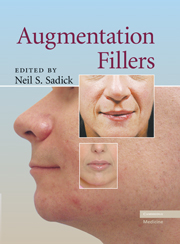Book contents
- Frontmatter
- Contents
- LIST OF CONTRIBUTORS
- Ch. 1 Application of Fillers
- Ch. 2 Approach to Choosing the Ideal Filler
- Ch. 3 Patient Selection, Counseling, and Informed Consent
- Ch. 4 Hyaluronic Acid Skin Derivatives
- Ch. 5 Collagen Products
- Ch. 6 Radiesse
- Ch. 7 ArteFill
- Ch. 8 Augmentation Fillers in Cosmetic Dermatology: Silicone
- Ch. 9 Advanta Expanded Polytetrafluoroethylene Implants
- Ch. 10 Sculptra
- Ch. 11 Lipo Transfer
- Ch. 12 BioAlcamid®
- Ch. 13 Combination of Approaches in Augmentation Fillers in Cosmetic Dermatology
- Ch. 14 Filling Complications
- Ch. 15 Postprocedure Management and Patient Instructions
- Ch. 16 Conclusion: Future Trends in Fillers
- INDEX
- References
Ch. 10 - Sculptra
Published online by Cambridge University Press: 26 February 2010
- Frontmatter
- Contents
- LIST OF CONTRIBUTORS
- Ch. 1 Application of Fillers
- Ch. 2 Approach to Choosing the Ideal Filler
- Ch. 3 Patient Selection, Counseling, and Informed Consent
- Ch. 4 Hyaluronic Acid Skin Derivatives
- Ch. 5 Collagen Products
- Ch. 6 Radiesse
- Ch. 7 ArteFill
- Ch. 8 Augmentation Fillers in Cosmetic Dermatology: Silicone
- Ch. 9 Advanta Expanded Polytetrafluoroethylene Implants
- Ch. 10 Sculptra
- Ch. 11 Lipo Transfer
- Ch. 12 BioAlcamid®
- Ch. 13 Combination of Approaches in Augmentation Fillers in Cosmetic Dermatology
- Ch. 14 Filling Complications
- Ch. 15 Postprocedure Management and Patient Instructions
- Ch. 16 Conclusion: Future Trends in Fillers
- INDEX
- References
Summary
INTRODUCTION
There has been a paradigm shift in cosmetic surgery. We are now replenishing volume that has been depleted in the facial region as opposed to removing excess skin that remains. Facial lipoatrophy is a facet of a more general condition, lipodystrophy. It is a symptom of various conditions that include congenital disorders, HIV-related therapies, and aging. Because facial lipoatrophy, regardless of cause, is a disfiguring condition that affects many people, several devices have been used in an attempt to provide aesthetic correction for this condition. Some of these injectable devices include fat, collagen, hyaluronic acids, calcium hydroxylapatite, silicones, poly-L-lactic acid (PLLA), and polymers such as polymethyl methacrylate and polyacrylamide. Sculptra is a synthetic, biodegradable, and biocompatible injectable composed of PLLA. This is one of the few substances approved in Europe and in the United States for correction of lipoatrophy that has pending cosmetic uses.
Injectable PLLA is a new class of devices that provides a semipermanent option to correct the visible signs of facial lipoatrophy. Sculptra was approved with CE Mark certification under the trade name New-Fill in Europe. It has been estimated that 150,000 patients in over thirty countries have been treated with New-Fill since 1999. Sculptra has been used to increase the volume of depressed areas, such as skin creases, wrinkles, folds, and scars. In 2004, PLLA's approval was extended in Europe to include the large volume corrections of facial lipoatrophy.
- Type
- Chapter
- Information
- Augmentation Fillers , pp. 89 - 102Publisher: Cambridge University PressPrint publication year: 2010



